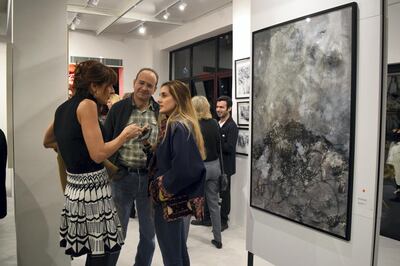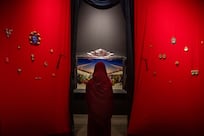At 33 years old, Nadine Kanawati has a bachelor's and a master's degree in fine arts from the Lebanese University in Beirut, but until this month had never taken part in a professional exhibition. She celebrated her debut last week at the inaugural show to be held at Cub Gallery, a new exhibition space in Beirut's trendy Badaro neighbourhood that is dedicated to supporting emerging artists.
Showcasing abstract mixed-media works on canvas, made using rubber from disintegrated car tyres, Kanawati had the distinction of being the artist with the work listed at the highest price – a modest US$2,300 (Dh8,448) for her largest piece, which measures 1.5 by 2 metres.
Her work is inspired by the Lebanese habit of burning car tyres in the streets as a symbol of protest. After visiting a factory that recycles tyres, she decided to work with shredded rubber to create monochrome paintings of circles with a unique rough texture.
“Using this material, I felt the anger that the Lebanese people feel,” she says.
“Our problems are like a loop. They go round and round in circles and they are never-ending.”

One problem facing young artists like Kanawati might be coming to an end now however, thanks to the niche filled by Cub. The new gallery – named after a baby bear – is dedicated to exhibiting the work of art students and recent graduates, helping to raise their profiles, while also providing an entry point for collectors looking to buy art at accessible prices.
“The whole concept for a space like this started because there is a huge lack in the market today, and in the development of Lebanese artists today, because once they graduate there is nowhere for them to go,” says gallery manager Christopher Rizkallah.
“Most galleries will not take them that seriously as a fresh graduate or as an emerging artist. Often artists have to leave the country, establish a name abroad and then come back to penetrate this gallery model, so with Cub we’re trying to be a stepping stone for artists so that they can start getting exposed just after graduation or while they’re still studying.”
The gallery, a collaboration between FFA Private Bank and the non-profit organisation Beirut Art Residency, opened on December 14. It is the first gallery space in Badaro, a popular new district of shops and restaurants near the National Museum of Beirut. The inaugural exhibition, which runs until February 14, features work by 17 young artists, all of whom are either students or recent graduates of art programmes at six Lebanese universities.
If Cub’s start-up costs were covered by private enterprise, the gallery follows a commercial model and is intended to support itself. “All the work is for sale and it functions like a normal gallery except the prices are a bit more accessible,” says Rizkallah. “It’s a gallery that offers affordable art for collectors, from the artists of tomorrow, because all of them are young artists, who will hopefully develop into bigger things.”
Artists studying at a Lebanese university or who have graduated in the past three years can submit their portfolios online.
The model of supporting those just starting out as professionals in the art world extends to many aspects of the way Cub Gallery is conceived and run.
Rizkallah graduated from the American University of Beirut three years ago with a degree in fine art. He says the gallery will hold exhibitions every two months, with one show a year curated by a student from Saint Joseph University or the AUB, both of which run Masters programmes in curatorial studies.
______________
Read more:
[ Remembering Galerie Épreuve d’Artiste, Lebanon’s wartime haven for artists ]
[ Art in the UAE: the exhibitions and installations to look out for in 2018 ]
[ Artist Timo Nasseri's journey to find calligrapher Ibn Muqla’s four Arabic letters ]
______________
The gallery was designed by Jeff Msanne, who graduated this year from the Lebanese University with a degree in architecture. His design includes external walls made of glass panels, giving the gallery a bright, airy feel, and modular internal walls that can be moved into many different configurations, making the small space unusually versatile. It is the winner of a competition organised by the gallery and judged by prominent local architect Youssef Tohme.
The work on show in the inaugural exhibition includes paintings, drawings, photographs and mixed-media. Sara Soup has three striking mixed-media-on-paper works featuring semi-abstract renditions of the human form in rich cobalt blue, entwined with what look like crows' beaks and talons.
Christian Sleiman shows three delicate, magical sketches of Beirut and Tripoli, executed on glass with black permanent marker, while Tarek Haddad displays three photographs partially covered with opaque tracing paper, revealing the faces of celebrities rumoured to have undergone plastic surgery, with chunks of raw potato representing their physical alternations.
"In general, across all species in nature, any sort of phenotypical changes that happen were defensive, a mechanism of the species, like butterflies changing colour so that they can survive," Hadad says. "Neoplasticity is about the 21st century and the changes that we inflict upon ourselves to adjust to society's pressures and norms."

A special side area of the gallery is dedicated to limited-edition prints. Prices start at $60 and Rizkallah says even the most expensive original works are unlikely to exceed $3,000. At the opening exhibition, prices for original drawings and paintings start at $225 and average under $1,500.
Jacques Vartabedian, who has a Master’s in fine arts from the Lebanese University, is showing two paintings of buildings under construction in Lebanon. Despite exhibiting both in the country and internationally, including holding three solo shows, he says Cub Gallery is a crucial addition to the art scene.
“I think the space is wonderful and the idea is great because it is really hard for students when they graduate to exhibit their works,” he says. “Sometimes they work for the diploma and nobody takes them because the big galleries have more established artists. It’s more of a risk to take young, emerging artists in an established gallery.”
Kanawati echoes his sentiment. “We need this so badly in our society,” she says. “It’s the first step that is never taken. Now I am 33 years old and I have a lot of works, but I don’t know how to gain exposure for myself. I don’t know how to market my work. So this is very important.”
For more information, see www.cubgallery.com





